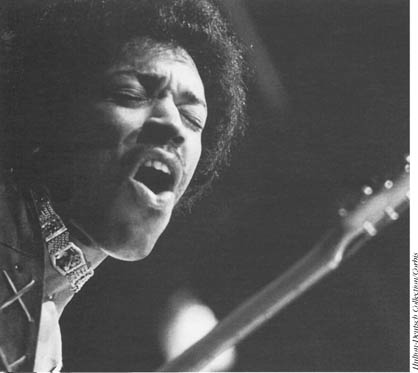
The late, and for many the greatest, rock star James Marshall Hendrix, taking guitar playing to the extreme.
During a short but spectacular public career, Hendrix changed the way the guitar is played through his innovative techniques and creative use of controlled distortion. He also altered the course of rock history by using the recording studio as an extension of the compositional process. Hendrix was born in Seattle on November 27, 1942. A self-taught guitarist, Hendrix learned by listening to recordings— especially those of blues greats such as Robert JOHNSON and Muddy WATERS. In high school, he played with various local bands before leaving to join the military, and while stationed in Kentucky he formed a rhythm-and-blues (R&B) group called the Casuals.
The early 1960s was a fertile time for Hendrix— discharged from the army in 1961, he went on to play in LITTLE RICHARD’S backing band and toured with R&B artists such as Solomon Burke, Ike and Tina TURNER, and the Isley Brothers. In early 1965, Hendrix joined a New York R&B group, Curtis Knight and the Squires, but quit later that year to form his own band, Jimmy James and the Blue Flames. It was during this time that he began to experiment with distorted electronic effects such as feedback and fuzz tone. Producer Bryan “Chas” Chandler, enthusiastic about Hendrix’s masterful playing, invited him to England and signed him to a management contract.

The late, and for many the greatest, rock star James Marshall Hendrix, taking guitar playing to the extreme.
In England, in 1966, Hendrix formed the Jimi Hendrix Experience with bassist Noel Redding and drummer Mitch Mitchell. The Experience released their first single, “Hey Joe,” in late 1966; their first album, Are You Experienced, followed in 1967. The album featured some stunning experimentation with instrumental sound effects and tape manipulation—from electronic distortion to passages where guitars and voices were mixed backward. This is a complex sound-scape of polyphonic (multiple-sound) textures, distorted improvisation, rapid guitar ornaments, intricate overdubbing, complex song structures, and image-laden lyrics. Subsequent albums refined these characteristics, resulting in clearer production quality and more fluid, less frantic guitar-playing. After a brief split, the Experience reformed in 1970 with Billy Cox on bass, and began recording a new album in the summer of 1970. The album was never finished. On the night of September 17, Hendrix took a quantity of drugs and chocked to death. A large backlog of his recordings surfaced posthumously. These give a clear insight into Hendrix’s compositional process and into the extraordinary guitar technique that has inspired so many artists who came after him.
Stephen Valdez
SEE ALSO:
AMPLIFICATION; BLUES; ROCK MUSIC.
FURTHER READING
Brown, Tony. The Final Days of Jimi Hendrix (London: Rogan House, 1997);
Dannemann, Monika. The Inner World of Jimi Hendrix (London: Bloomsbury, 1995).
SUGGESTED LISTENING
Are You Experienced?; Axis: Bold As Love; Band of Gypsies; Electric Ladyland; The Ultimate Experience.